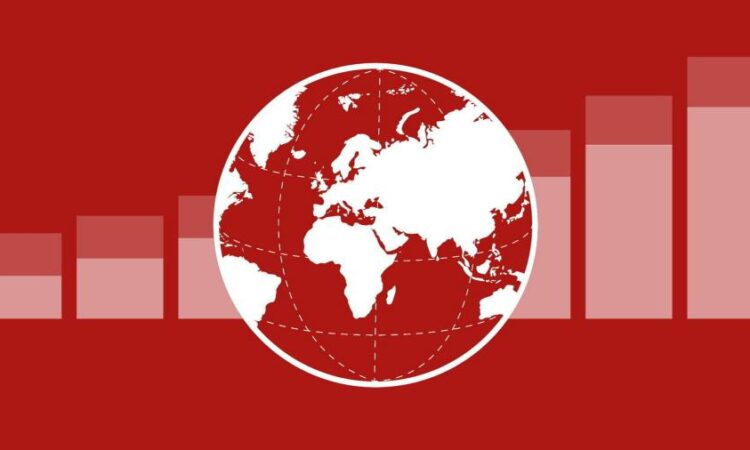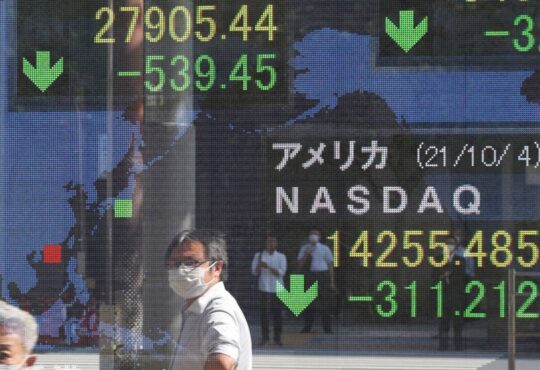
Receive free Markets updates
We’ll send you a myFT Daily Digest email rounding up the latest Markets news every morning.
US stocks rose on Wednesday as long-term Treasury yields moderated from their recent highs, and new data signalled a slowdown in economic growth ahead of the symposium of central bankers in Wyoming.
Technology and media stocks helped the benchmark S&P 500 finish 1.1 per cent higher, while the Nasdaq Composite added 1.6 per cent, aided by a 3.2 per cent rise for Nvidia, the world’s most valuable semiconductor company.
The US chipmaker, whose shares are up more than 200 per cent this year and has helped propel the rally in artificial intelligence-related tech stocks, released forecast-beating earnings after the market close.
“It seems to me that the market is expecting an encore, not a reaffirmation,” said Steve Sosnick, chief market strategist at Interactive Brokers. “When you see a stock go up this dramatically into its earnings, it gives them a very high bar that they have to leap over.”
Nvidia earnings appeared to have cleared that bar, sending its shares about 8 per cent higher in after-hours trading.
But the main focus for many investors this week remains movements in government bond markets and monetary policy expectations.
Yields on the benchmark 10-year US note moderated, falling 0.13 percentage points to 4.20 per cent after reaching a 16-year high earlier this week. The yield on the two-year US Treasury fell 0.06 percentage points to 4.97 per cent. Bond yields fall as prices rise.
The moves came after S&P Global’s flash US Composite PMI index, a measure of manufacturing and service activity, fell to 50.4 in August from 52 in July, its largest decline since November. Signs of tepid economic data may help bolster expectations central banks could soon begin to loosen monetary policy, although that is not the outcome markets regard as most likely.
The weaker numbers mirrored similarly weak reports on business activity in the UK and the eurozone. German and UK bond yields fell on Wednesday as traders bet that slowing economies would force central banks to cap interest rate rises.
In recent weeks, investors had fretted that a succession of robust economic data over the summer would persuade the Federal Reserve to keep interest rates higher for longer as it tries to tame persistent price increases.
“But I think the early morning data that we got from the UK and the EU — Germany in particular — were super weak,” said William O’Donnell, head of US rates strategy at Citigroup.
“It’s hard for me to imagine that the US can go on its merry way . . . at a time when you have recessionary conditions emerging in Europe and the UK [and] deflationary conditions in China. I think people are questioning the veracity of their bond bearish outlook,” O’Donnell continued.
Investors will pay close attention to the economic conference in Jackson Hole, Wyoming, which begins on Thursday, and a speech there on Friday from Fed chair Jay Powell, who is expected to signal the central bank’s future monetary tightening path.
“Powell’s probably going to reiterate that they still have to make sure to kill inflation . . . and in that sense effectively ensuring that economic growth slows somewhat,” said Gennadiy Goldberg, TD Securities’ head of US rates strategy.
“We actually think the Fed’s not going to be hiking any more this year . . . [so] how long do they actually hold rates steady at these levels? That’s really the million dollar question.”
Traders expect the central bank to begin cutting rates in May, but Interactive Brokers’ Sosnick said the economic picture may not justify monetary easing.
“I don’t think it’s fair to think you’re going to have a soft enough landing to keep the economy steady and see a Fed that’s willing to cut rates. It’s difficult to expect both.”
In Europe the HCOB flash eurozone composite purchasing managers’ index fell to a 33-month low of 47 in August, below market expectations of 48.5.
Yields on the policy-sensitive two-year German Bunds fell 0.12 percentage points to 2.97 per cent, their lowest level since early June. The yield on the 10-year gilt fell 0.2 percentage points to 4.46 per cent, its largest one-day fall since the collapse of Silicon Valley Bank in March.

The European Central Bank had last raised interest rates by a quarter percentage point to 3.75 per cent in July, a level not seen since 2001.
On Wednesday traders had priced in a 52 per cent probability that the ECB would go ahead with a quarter-point rise at the next policy meeting, according to data compiled by Refinitiv and based on interest rate derivatives prices.
The region’s stock markets picked up as traders weighed whether the data would put pressure on the ECB to halt its campaign of interest rate rises in the 20-country bloc.
The region-wide Stoxx Europe 600 traded 0.4 per cent higher, while France’s CAC 40 added 0.1 per cent and Germany’s Dax was up 0.2 per cent.
Meanwhile, Asian markets were mixed on Wednesday, with China’s CSI 300 falling 1.6 per cent and South Korea’s Kospi down 0.4 per cent, while Hong Kong’s Hang Seng rose 0.3 per cent and Japan’s Topix advanced 0.5 per cent.





